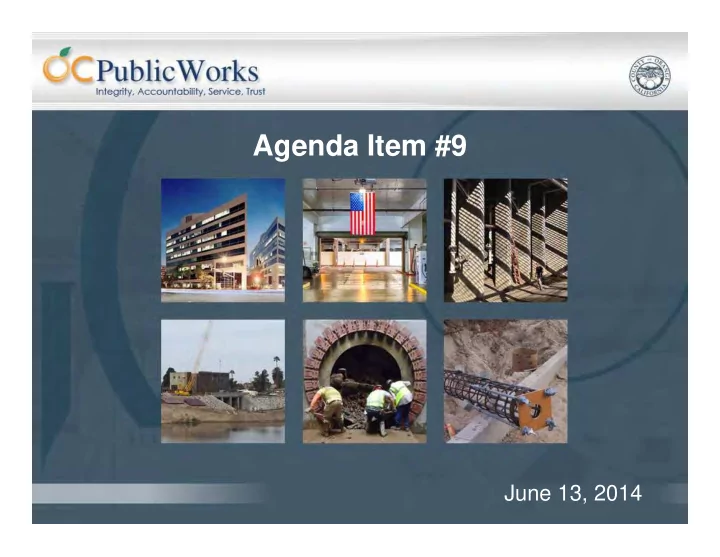

Agenda Item #9 June 13, 2014
Overview Countywide Perspective • Orange County Stormwater Program • Stormwater Permits and Urban Runoff • Critical Policy Issues City Perspective Richard Boon, County of Orange Amanda Carr, City of Irvine Gene Estrada, City of Orange
Orange County Stormwater Program • 24 years of program implementation (MS4 permits since 1990) • County and City staff bring 100’s of years of collective water quality experience • Nationally recognized consultant expertise has assisted in all areas of program development • Highly acclaimed program elements: • Land Development – OC Engineering Council Engineering Project Achievement Award 2012 • Public Education – CASQA Outstanding Outreach and Media Project; APWA Model Program
Program Management Costs $63m
Program Implementation Costs $1,160m
Stormwater Permits The federal Clean Water Act requires that stormwater permits for discharges from municipal storm sewers: • shall include a requirement to effectively prohibit non- stormwater discharges into the storm sewers; and • shall require controls to reduce the discharge of pollutants to the maximum extent practicable , including management practices, control techniques and system, design and engineering methods, and such other provisions as the Administrator or the State determines appropriate for the control of such pollutants.
Urban Runoff There are four interrelated but separable effects of land-use changes on the hydrology of an area: changes in peak flow characteristics, changes in total runoff, changes in quality of water, and changes in the hydrologic amenities. Luna Leopold, USGS, 1968
Pre-Development Landscape 30% Evapotranspiration 10% Surface Flow 20% Interflow 40% Infiltration
Post Development Landscape 15% Evaporation 75% Surface Flow to Pipes 5% Interflow 5% Infiltration
Permit Renewal The Permit Writer
Critical Policy Issues 1. Affirming the “Iterative Process” 2. Recognizing Progress 3. Findings – “Bridging The Analytic Gap” 4. Applying “Maximum Extent Practicable” 5. Land Development – No Basis For Change 6. Enabling Program Development
1. Affirm "Iterative Planning Process"
2. Recognize Progress: Bacteria
Recognize Progress : Nutrients
Recognize Innovative Use of Drainage Infrastructure Dry weather diversions to treatment plants / wetlands
Recognize Progress: Pesticides Summary of Toxicity - California Watersheds – SWRCB – 2010 • 992 sites - 48% exhibited toxicity • With the exception of ammonia, all evaluations implicated pesticides. New DPR rule will largely--but not completely-- end widespread water and sediment toxicity from pyrethroids in California's urban watersheds (Kelly Moran, PhD, pers.comm.).
Recognize Progress: Copper • Principal sources of copper in urban runoff: vehicle braking , architectural copper and ornamental ponds/swimming pools. • SB346 (Kehoe) 2010 Vehicle Brakepads 2021 – No more than 5% Cu by weight 2025 – No more than 0.5% Cu by weight
3. Directives Require Findings Findings must “bridge the analytic gap between the raw evidence and ultimate decision or order.” WQ Order 95 ‐ 4
Examples XIV.C. Now requires cleaning and inspection of underground drains in addition to open channels $6.3 Million for CCTV of 600 miles of storm drain.
3. Land Development: No Case For Change 2003 ‐ 2011 2011 ‐
Contributed by Gene Estrada, City of Orange
Contributed by Gene Estrada, City of Orange
Land Development: No Case For Change Product of 2 year stakeholder development process $1.5m development costs Only 2 years into implementation (Less than 1 year in South Orange County No evaluation of LID BMP performance No technical justification for proposed changes - which would be very costly No findings in permit
Examples XII. Changes BMP Lexicon XII.A. Creates new requirements for General Plans XII.B.1 50 Days for Implementation XII.B.2 “Priority” or “Non-Priority” XII.C.6 Prescription of mechanisms XII.C.10 Recordation of Project WQMPs X.D.1.c 80% capture XII.D.3 48 Hour Drawdown time XII.D.8 Requires entry on to private property XII.E.1 BMPs require peer reviewed performance data XII.F.4 & G.5 Requires mitigation of infiltration constraints
Examples XII.G.1.d. 1.5x Biotreatment Sizing XII.I.2. 10’ Groundwater Separation XII.N.1.b. No hydromodification exemption for engineered channels XII.N.2. Hydromodification performance standard is changed
3. Going Beyond "Maximum Extent Practicable" MEP Benefit COST For example: The 80 th percentile runoff event is now considered cost effective and is the design event that achieves the MEP definition under the Clean Water Act – WEF/ASCE, 1998
Examples XII.F.4 & G.5 Appears to require mitigation of infiltration constraints
Examples XII.B.2. All development projects must now be categorized as “Priority” or “Non-Priority”
Screened Regional BMP Opportunity Locations Screened Regional BMP Opportunity Locations
Regional Opportunities ‐ Contributing Areas Regional Opportunities ‐ Contributing Areas
6. Enable Program Development
Examples VII.E.3.a. Requires Executive Officer approval of individual drain inlet screen replacement IX. and X. Retain current inspection frequencies for industrial and commercial sites XIV.C. May preclude use of proprietary BMPs Requires quarterly update of existing development inventories
Inspection
Summary • Affirm “Iterative Process” • Recognize progress and successes • Provide additional findings • Recognize MEP and thresholds of significance • Continue Model WQMP/TGD • Remove “prescription" that is counter- productive
Conclusion
TMDLs Permittees generally support the approaches, including BMP-based compliance options. However, TMDL provisions lack clarity and are improperly transcribed into the Draft Order. • Compliance provisions lack clarity • For BMP ‐ based compliance option: o Process is inconsistent with TMDL BPAs (including schedule) o Does not recognize existing plans o 6 month development timeframe is insufficient o TMDL Appendices contain (unnecessary) inconsistencies with Basin Plan Amendments Vs.
20% Evapotranspiration Low Impact Development 35% Infiltration 10% Interflow 35% Surface Flow
Recommend
More recommend